繼“分析資料”之后,小學PYP 課堂順利地進入了第三階段的學習——深入探究。在本階段的學習中,學生以“抽象——具體——抽象——具體”的閉環式學習順序,首先學習了能量的主要形式和分類,并聯系生活實際分享交流主要能量轉換的實例,繼而了解“能量守恒定律”概念,較后以小組協作方式合作探究分析案例并完成實驗。
Following the "analysis of data", the primary school PYP classes successfully entered the third stage of learning-in-depth exploration. In this stage of learning, students follow the closed-loop learning sequence of "abstract-concrete-abstract-concrete", first learn the main forms and classifications of energy, and share and exchange examples of major energy conversions in connection with life practices, and then Understand the concept of "Energy Conservation Law", and finally cooperate in group cooperation to explore and analyze cases and complete experiments.
課堂以小組討論和實驗為主軸,著重培養學生“信息素養”探究技能:學生在課堂制定和規劃實驗分工和流程,進行實驗數據收集記錄與交流,并對實驗過程和結果進行綜合和解讀,老師對學生探究過程做出形成性評價,營造了“做中學、樂中學”的課堂氛圍,引導學生習得研究方法,提高研究技能。
Classroom focuses on group discussion and experimentation, focusing on cultivating students’"information literacy" inquiry skills: students formulate and plan experimental divisions and procedures in the classroom, collect experimental data, record and exchange experimental data, and synthesize and interpret experimental processes and results. Teacher A formative evaluation of the students’ inquiry process is made, creating a classroom atmosphere of “learning by doing and learning by fun”, guiding students to acquire research methods and improve research skills.
世界如何運作?
本輪,四年級探究的超學科主題是:“世界如何運作”。學生主要以“能量的形式與來源”、“能量的儲存與轉化”、以及“如何合理利用能量”為探究線索學習“能量”。
In this round, the transdisciplinary theme explored in the fourth grade is: "How the world works". Students mainly study "energy" with "forms and sources of energy", "energy storage and transformation", and "how to use energy rationally" as inquiring clues.
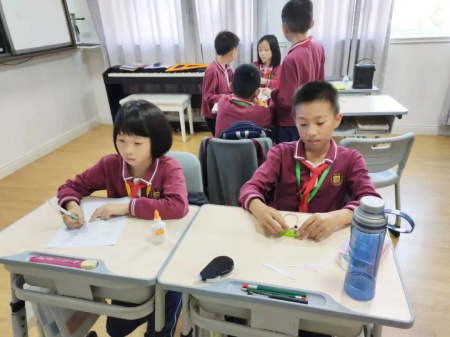
概念驅動,評價交流——能量的形式與來源
在深入探究的過程中,學生了解能量的形式與來源,了解了械能、內能、電能、電磁能、核能、化學能、能量守恒定律等科學知識,通過概念驅動學生逐步深入探究,學生交流觀察到的生活中各種能量的事例,理解分析主要的能量類型,為進一步研究能量轉換提供基礎。
Concept-driven, evaluation and communication-the form and source of energy In the process of in-depth exploration, students understand the form and source of mechanical energy, understand the scientific knowledge of mechanical energy, internal energy, electrical energy, electromagnetic energy, nuclear energy, chemical energy, energy conservation law, etc., and drive students to gradually in-depth exploration through concepts , Students exchange observed examples of various energy in life, understand and analyze the main energy types, and provide a basis for further research on energy conversion.
收集記錄,綜合解讀——能量的儲存與轉換
讓學生在“做中學”,在“樂中學”,課堂以兩大探究活動為支架,深入研究能量的儲存與轉換。
Collect records, comprehensive interpretation-energy storage and conversion Let students learn by doing. In our school, the classroom uses two large inquiry activities as a framework to study the storage and conversion of energy in depth.
學生以異質小組形式,討論與真實生活緊密聯系的趣味故事,從趣味故事中發現能量轉換。首先,學生收集并記錄發現故事中隱藏的能量轉換信息;然后,小組自主制定和規劃各成員分工,進行數據分析與綜合整理,交流合作完成氣泡圖、Y形圖等不同類型的思維導圖;較后,通過小組匯報成果的形式,有層次有條理的解讀了化學能轉化機械能、化學能轉化內能、電能能轉化光能等能量轉換。
In the form of heterogeneous groups, students discuss interesting stories closely related to real life, and discover energy conversion from interesting stories. First, students collect and record the energy conversion information hidden in the story; then, the group independently formulates and plans the division of labor among members, conducts data analysis and comprehensive arrangement, communicates and cooperates to complete different types of mind maps such as bubble charts and Y-shaped charts; Finally, through the form of the group’s report results, a systematic interpretation of the energy conversion of chemical energy into mechanical energy, chemical energy into internal energy, electrical energy into light energy, etc.
課堂從理論到實踐,知行合一,以“點亮小燈泡”實驗引導學生繼續深入研究電能轉化光能的能量轉換,思考和討論如何讓電路連接讓燈泡亮起來。學生小組協作,經過“分析——評價——形成決定”自主完成能量轉換實踐:實驗前,學生觀察與分析實驗器材,規劃實驗步驟;在實驗操作中,學生進行數據收集與同步記錄,在組內討論與教師指導下生成形成性評價;在實驗結論階段,學生根據不斷調整實驗策略,形成實驗決定,完成實驗報告并繪制電路圖。
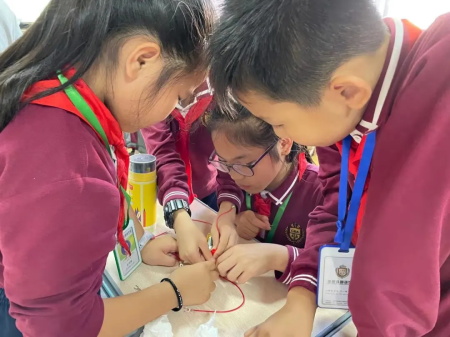
From theory to practice, the class combines knowledge and action, and uses the "light up a small bulb" experiment to guide students to continue to study the energy conversion of electrical energy into light energy, thinking and discussing how to connect circuits to make the light bulb light up. Students work in a group to complete the energy conversion practice independently through "analysis-evaluation-formation decision": before the experiment, the students observe and analyze the experimental equipment and plan the experimental steps; in the experimental operation, the students conduct data collection and synchronous recording, in the group Formal evaluations are generated under the guidance of internal discussions and teachers; in the experimental conclusion stage, students continuously adjust experimental strategies to form experimental decisions, complete experimental reports and draw circuit diagrams.
在趣味性和操作性極強的活動中,孩子們始終興趣盎然地積極探究,從交流討論到實驗合作,從失敗到成功,孩子們品嘗到了探究學習的樂趣,在動手操作中,掌握了探究方法與技能。
In the fun and operation activities, children are always active in exploring with interest. From communication and discussion to experiment cooperation, from failure to success, children taste the fun of inquiry learning, and master the inquiry in the hands-on operation. Methods and skills.
聯系生活,批判思考——如何合理利用能量
老師通過“點亮小燈泡”實驗,質疑開關裝置是否需要,引發學生批判性思考,如何合理利用能量。學生在討論中明白節約能源的意義與重要性,在生活中主動肩負起節能環保的責任。
The teacher questioned the need for a switch device through the "light up a small light bulb" experiment, triggering students to think critically about how to use energy rationally. During the discussion, students understand the significance and importance of energy conservation, and take the initiative to take the responsibility of energy conservation and environmental protection in life.



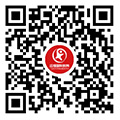
 公眾號
公眾號

















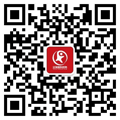

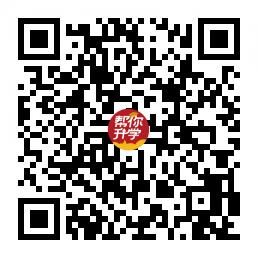


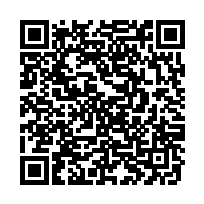
 服務熱線
服務熱線
